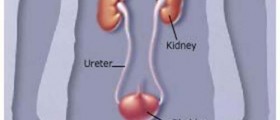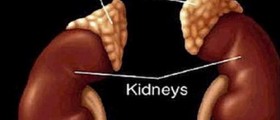
Glands are organs in the human and animal bodies involved in synthesis and release of substances known as hormones. Hormones are important chemicals that send out messages and affect the cells in other parts of the organism. A small number of hormones is also required to alter the cell metabolism. Some other glands, however, do not produce hormones but other substances such as saliva, breast milk or sweat. Generally, all glands are classified as either exocrine or endocrine glands. Exocrine glands retain ducts to body surfaces, while endocrine glands lack ducts and release their products across the cell membrane into interstitial spaces around the cells.
Endocrine Glands of the Human Body
Pituitary gland, or hypophysis, is an endocrine gland situated at the bottom of the hypothalamus, at the base of a brain. The gland is the size of a pea, and it is responsible for secretion of six different hormones, each involved in maintaining normal homeostasis.
Adrenal glands are positioned on the top of the kidneys. They are also known as suprarenal glands. The right gland is triangular shaped while the left gland is semilunar shaped. These glands are involved in the production and secretion of stress hormones.
Thyroid gland is one of the largest endocrine glands in the human body. The gland is butterfly-shaped and situated in the neck, below the thyroid cartilage. This gland regulates the metabolism and controls how sensitive the body should be to other hormones.
Hypothalamus is a portion of the brain and a link between the nervous system and the endocrine system, via the pituitary gland. The hypothalamus controls body temperature, hunger, thirst, fatigue, sleep and circadian cycles.
The prostate is the endocrine gland found in male mammals. Its function is to store and secrete a slightly alkaline fluid that usually constitutes 20-30% of the volume of the semen. The prostate also contains muscles that help eject semen during ejaculation.
The thymus is a gland involved in the production and "instruction" of T-lymphocytes (T cells), which are critical cells of the adaptive immune system.
The pancreas is a gland responsible for the production of several different hormones, including insulin, glucagon and Somatostatin, as well as secretion of pancreatic juice.
Pineal gland is a small endocrine gland in the vertebrate brain involved in the production of the serotonin, a monoamine neurotransmitter involved in mood regulation and control of the sleep-cycles.
Exocrine Glands of The Human Body
The lacrimal glands are almond-shaped glands found in each eye. Their primary function is to produce tears.
Sweat glands are small tubular structures of the skin that produce sweat. The sweat contains water and salts and helps to regulate the body’s temperature.
Salivary glands are exocrine glands involved in the production of saliva. The saliva aids the digestion of the food in the mouth.
The mammary glands are found in breasts, and they produce milk to feed the offspring. These are actually enlarged and modified sweat glands.
The sebaceous glands are microscopic glands in the skin which secrete a substance known as sebum, and lubricate the hair of mammals.
















Your thoughts on this
Loading...